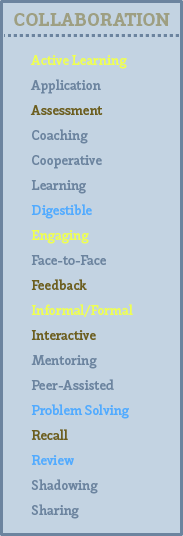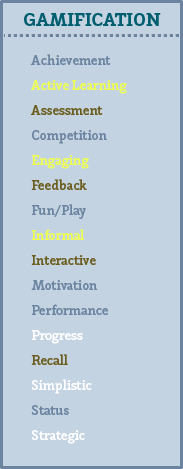As we look around college classrooms today, they are beginning to resemble the workforce. The diversity of learners has increased with the changes in the nontraditional student population over the past few decades. Nontraditional learners are becoming the new face of students in higher education, just as they have always been the learners in the workforce. The numbers of adults in the classroom are expected to continue to increase over time. Primary among the many reasons for this change are “an aging and increasingly diverse population, the rapid pace of technological change, and the constantly shifting demands of the workplace in this era of a global economy” (Ross-Gordon, 2011, p. 26). Therefore, we are seeking ways to not only teach these diverse populations in higher education but also to train the diverse populations in the workforce.
Introduction
In reviewing the needs of nontraditional learners, both in the workforce and in higher education, we found some similarities and overlapping concepts that could assist with learning, retention and motivation among adults. Nontraditional learners in higher education tend to have other priorities, such as families and jobs. Ross-Gordon (2011) presented a 2003 NCES report titled Work First, Study Second in which more than half of the undergraduate students surveyed viewed themselves as workers who were students. Meanwhile, Houle, Chiocchio, Favreau and Villeneuve (2012) explored the concepts of family interfering with work and work interfering with family. Though the authors’ study was based on factors of how family and work interfered with each other, it provides a clear view of the role conflict. Are workers parents first?
The individual’s view of his or her primary role often defines that same role in learning. More often than not, we are finding that be it in education or training, the learner is not a learner first. So, how can we adapt the learning tasks to fit learners’ needs and ensure that they learn? If we begin with microlearning as a concept to provide learners with small amounts of information to fit their needs and the hectic schedules created by the many roles they play in their daily lives, they will be more able to digest the information. Coupling this with collaboration, in which learners are able to share their new knowledge with others and gain additional knowledge from them would provide mastery of the required material. This leaves us with the question of how to motivate the learner. There is a simple answer that is frequently used in business today, gamification.
The Tierce Design is based on the idea of using these three basic components, which are adaptable to any learning environment. Through microlearning, collaboration and gamification, we can reach a wider audience of learners in any setting. The material is catered to individual learners and the group as a whole when it is presented in small chunks that provide learning material for those who are students first while not interfering with the time constraints and needs of those who are not. It provides for the time-honored and proven model of learning from slightly more knowledgeable peers through the sharing of the new knowledge from many perspectives. Finally, it provides motivation, both intrinsic and extrinsic, by allowing learners to work toward not only the goal of increased knowledge but also toward goals that are more tangible to them. So where do we start?
Adult Learning Theory
The concept of teaching and training adults is not new; Knowles developed the adult version of pedagogy, andragogy, in 1974. He based this adult learning theory on four basic characteristics of adult learners:
- They are self-directed, take responsibility for their own actions and resist having information arbitrarily imposed on them.
- They have an extensive depth of experience, which serves as a critical component in the foundation of their self-identity.
- They are ready to learn. Because most adult learners return to college voluntarily, they are likely to actively engage in the learning process.
- They are task motivated. Adult students returning to college attend for a specific goal and the primary component of their motivational drive tends to be internal (Knowles, 1984).
Tierce Design embraces and addresses these characteristics as integral to planning and implementing curricula or training programs. Using microlearning addresses the four characteristics by providing small amounts of information to be learned independently that can be related to the learner’s experience or current knowledge, thus building a higher level of knowledge. Sharing this knowledge with others, collaboration, addresses the four characteristics as well. Sharing is a self-regulated task that promotes the self-identity of the one who understands the material as well as the one who can build on that new knowledge through the process. Gamification ensures that the material is viewed as necessary, because the instructor is willing to instill a reward for its mastery, providing a game-like atmosphere to build upon self-identity while promoting active engagement and goal achievement.

Microlearning
Microlearning divides large, more complex amounts of required information into more manageable, relatable and understandable chunks. Providing information in smaller portions does not overwhelm learners and often motivates them to master the material presented. Aitchanov, Nussipbekov, and
Zhaparov (2012) explained how people are using microlearning in their everyday lives, unconsciously, “while reading tutorials, forums, wiki, blogs and other things like this” (p. 149). They described microlearning as a step-by-step plan for learning everything about a topic.
The key components that we identified consisted of interacting with small amounts of information, in a relatively small timeframe, to master a chain of related topics that lead to information mastery on a larger scale. This allows learners to take ownership of the learning activity, pacing themselves as they personalize their learning experiences. Microlearning creates an active learning environment for learners because they are less anxious and more engaged in the learning process. It is often viewed as informal, short, simplistic and flexible, with easily accessible information that is ideal for any attention span. Using timely topics with small content bites allows the learner to easily digest, retain and recall the information presented for review and leads to improved problem solving.
Collaboration

Hartley (2010) suggested that microlearning is a collaborative experience in that it involves coaching through the use of learning leaders in many instances and is enhanced by visiting and discussing learned topics with coworkers. We found several aspects in common between the two as well. Both lead to improved problem solving through engaging
informal learning practices that promote active learning. Himes and Ravert (2012) found that students were able to learn more by communicating informally with peers due to their ability to understand each other, subsequently increasing their achievement and mastery in a learning environment. Citing a survey “conducted in March and April of 2012 by social learning expert Jane Hart, founder of the Centre for Learning Technologies and the Social Learning Centre” (p. 27), Lombardozzi (2012) showed a rise in the use of social tools, including collaboration, in the workforce.
There are many ways to provide a collaborative environment for learners. Each setting is unique, as are the collaborative practices used. We identified several components of collaboration that can be tailored to the autonomous needs of learners in any setting. Most learners excel through face-to-face interaction because they are able to confirm or improve their understanding of learned material through coaching, mentoring, shadowing or peer-assisted learning. Learners are also better able to interact with a topic because the information is more digestible when it can be recalled, reviewed and discussed as it is shared with others. Cooperative learning environments, such as collaboration, provide learners with the ability to apply their new knowledge and have their mastery assessed through the sharing process.

Gamification
Another aspect of assessment is found in gamification. Learning begins in childhood, with games, stories and songs intended to teach basic skills and lessons. Games as a learning tool need not stop with adulthood because
the playing of games does not necessarily stop in childhood in this age of technology. Gamification takes the basic premise of play but uses elements of games in nongaming contexts. Erenli (2013) provided several facts derived from various websites that indicated the potential of games in education and learning. These included that the average age range of gamers and game purchasers was late thirties to early forties, just under the average age of the workforce as indicated by the California Employment Development Department (EDD) (2001), with 29 percent being over the age of 50.
As an active learning tool, gamification provides an informal, simplistic platform for assessing performance and retention, using competition to gauge progress in some settings. This fun, interactive approach strategically provides a method of encouraging universal engagement and motivation, not only through play but through status from achievement. The concept provides for feedback through the use of leaderboards, badges, level systems, specified achievements and/or rewards depending on the needs of the material, setting or learner.
Conclusion
Gamification is not a new concept. However, the use of software-based gaming is new in that it is becoming more prevalent, as are software-based microlearning options and collaboration tools that take us beyond the constraints of space and time. These three teaching tools each provide for active learning in a less intimidating, informal way that is engaging to the learner. Though software and technology are the aspects that are mainly discussed, learning leaders do not have to require their use. Textbooks and training manuals have already been designed that use microlearning, each based on an outline. This allows for the division of learning without a software requirement. Collaboration can be as simple as a discussion or team project to demonstrate mastery. Gamification can be the earning of rewards and badges that are printed and handed out.
A Call for Action Research
Having theoretically hypothesized the learning opportunities and outcomes, Tierce Design requires testing and validation in both educational and workplace settings. This could be done through the implementation of Tierce Design into a small classroom setting as an action research study, as well as in ongoing corporate training programs.
References
Aitchanov, B., Nussipbekov, A., & Zhaparov, M. (2012). Microlearning of web fundamentals based on mobilelearning. International Journal of Computer Science Issues (IJCSI), 9(6), 148–150. Retrieved from http://ijcsi.org/papers/IJCSI-9-6-3-148-150.pdf
California Employment Development Department. (2001). The new workforce: Age and ethnic changes. Sacramento, CA: J. L. McClellan & R. Holden. Retrieved from http://wdr.doleta.gov/conference/pdf/holden.pdf
Erenli, K. (2013). The impact of gamification. International Journal of Emerging Technologies in Learning, 8(S1): 15–21. doi:10.3991/ijet.v8iS1.2320
Hartley, D. (2010). Is there macro value in microlearning? Chief Learning Officer, 9(7), 30–43. Retrieved from http://clomedia.com/articles/view/is_there_macro_value_in_microlearning
Himes, D. O., & Ravert, P. K. (2012). Situated peer coaching and unfolding cases in the fundamentals skills laboratory. International Journal of Nursing Education Scholarship, 9(1), 1–19. doi:10.1515/1548-923X.2335
Houle, L., Chiocchio, F., Favreau, O. E., & Villeneuve, M. (2012). Role conflict and self-efficacy among employed parents: Examining complex statistical interactions. Gender, Work & Organization, 19(6), 592–614. doi:10.1111/j.1468-0432.2011.00562.x
Kenner, C., & Weinerman, J. (2011). Adult learning theory: Applications to non-traditional college students. Journal of College Reading And Learning, 41(2), 87–96.
Knowles, M. S. (1984). Andragogy in action. San Francisco, CA: Jossey-Bass Publishers.
Lombardozzi, C. (2012). Collaboration is most essential to learning. T+D, 66(11), 27.
Ross-Gordon, J. M. (2011). Research on adult learners: Supporting the needs of a student population that is no longer nontraditional. Peer Review, 13(1), 26–29. Retrieved from http://www.aacu.org/peerreview/pr-wi11/prwi11_RossGordon.cfm


